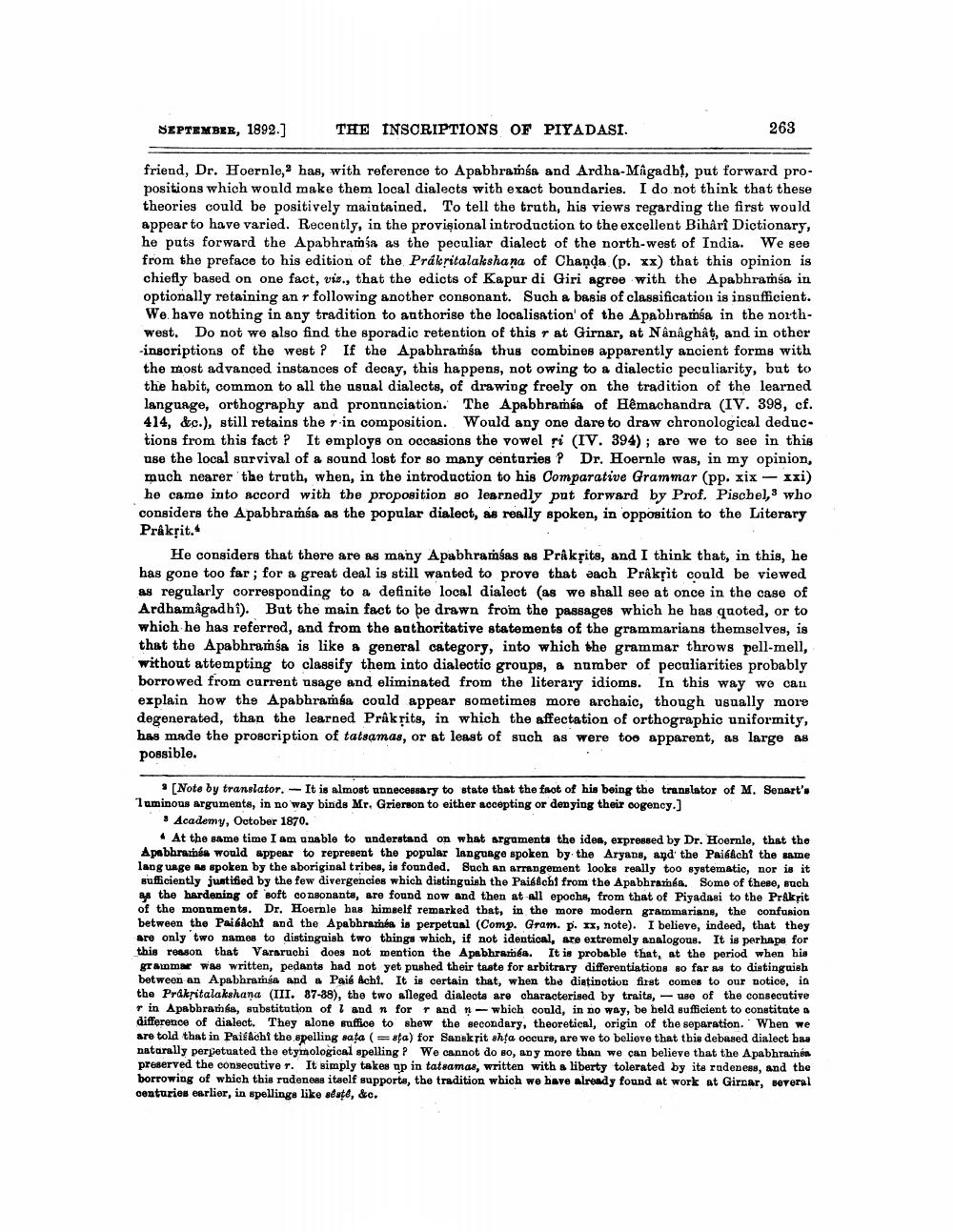________________
THE INSCRIPTIONS OF PIYADASI.
SEPTEMBER, 1892.]
friend, Dr. Hoernle, has, with reference to Apabhramsa and Ardha-Magadh, put forward propositions which would make them local dialects with exact boundaries. I do not think that these theories could be positively maintained. To tell the truth, his views regarding the first would appear to have varied. Recently, in the provisional introduction to the excellent Bihârî Dictionary, he puts forward the Apabhramia as the peculiar dialect of the north-west of India. We see from the preface to his edition of the Prákṛitalakshana of Chanda (p. xx) that this opinion is chiefly based on one fact, viz., that the edicts of Kapur di Giri agree with the Apabhramsa in optionally retaining an r following another consonant. Such a basis of classification is insufficient. We have nothing in any tradition to authorise the localisation' of the Apabhramsa in the northwest. Do not we also find the sporadic retention of this r at Girnar, at Nânâghât, and in other -inscriptions of the west ? If the Apabhramsa thus combines apparently ancient forms with the most advanced instances of decay, this happens, not owing to a dialectic peculiarity, but to the habit, common to all the usual dialects, of drawing freely on the tradition of the learned language, orthography and pronunciation. The Apabhrama of Hêmachandra (IV. 398, cf. 414, &c.), still retains the r in composition. Would any one dare to draw chronological deductions from this fact? It employs on occasions the vowel ri (IV. 394); are we to see in this use the local survival of a sound lost for so many centuries ? Dr. Hoernle was, in my opinion, much nearer the truth, when, in the introduction to his Comparative Grammar (pp. xix - xxi) he came into accord with the proposition so learnedly put forward by Prof. Pischel, who considers the Apabhramsa as the popular dialect, as really spoken, in opposition to the Literary Prakrit
263
He considers that there are as many Apabhramsas as Prakrits, and I think that, in this, he has gone too far; for a great deal is still wanted to prove that each Prakrit could be viewed as regularly corresponding to a definite local dialect (as we shall see at once in the case of Ardhamâgadhi). But the main fact to be drawn from the passages which he has quoted, or to which he has referred, and from the authoritative statements of the grammarians themselves, is that the Apabhramsa is like a general category, into which the grammar throws pell-mell, without attempting to classify them into dialectic groups, a number of peculiarities probably borrowed from current usage and eliminated from the literary idioms. In this way we can explain how the Apabhramsa could appear sometimes more archaic, though usually more degenerated, than the learned Prakrits, in which the affectation of orthographic uniformity, has made the proscription of tatsamas, or at least of such as were toe apparent, as large as possible.
[Note by translator. It is almost unnecessary to state that the fact of his being the translator of M. Senart's luminous arguments, in no way binds Mr. Grierson to either accepting or denying their cogency.]
Academy, October 1870.
At the same time I am unable to understand on what arguments the idea, expressed by Dr. Hoernle, that the Apabhrachés would appear to represent the popular language spoken by the Aryans, and the Paisach? the same language as spoken by the aboriginal tribes, is founded. Such an arrangement looks really too systematic, nor is it sufficiently justified by the few divergencies which distinguish the Paisßcht from the Apabhraméa. Some of these, such as the hardening of soft consonants, are found now and then at all epochs, from that of Piyadasi to the Prakrit of the monuments. Dr. Hoernle has himself remarked that, in the more modern grammarians, the confusion. between the Paisacht and the Apabhraméa is perpetual (Comp. Gram. p. xx, note). I believe, indeed, that they are only two names to distinguish two things which, if not identical, are extremely analogous. It is perhaps for this reason that Vararuchi does not mention the Apabhraméa. It is probable that, at the period when his grammar was written, pedants had not yet pushed their taste for arbitrary differentiations so far as to distinguish between an Apabhramsa and a Paié Achi. It is certain that, when the distinction first comes to our notice, in the Prakritalakshana (III. 87-88), the two alleged dialects are characterised by traits, -use of the consecutive rin Apabbramsa, substitution of l and n for r and which could, in no way, be held sufficient to constitute a difference of dialect. They alone suffice to shew the secondary, theoretical, origin of the separation. When we are told that in Paifichi the spelling sata (=sta) for Sanskrit shța occurs, are we to believe that this debased dialect has naturally perpetuated the etymological spelling? We cannot do so, any more than we can believe that the Apabhraméa preserved the consecutive r. It simply takes up in tatsamas, written with a liberty tolerated by its rudeness, and the borrowing of which this rudeness itself supports, the tradition which we have already found at work at Girnar, several centuries earlier, in spellings like seste, &c.




